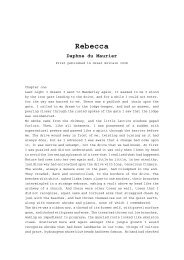Brand Failures
Brand Failures
Brand Failures
Create successful ePaper yourself
Turn your PDF publications into a flip-book with our unique Google optimized e-Paper software.
Idea failures 51<br />
Mattel explained that the new look was an effort to bring Ken up to date.<br />
‘We did a survey where we asked girls if Barbie should get a new boyfriend<br />
or stick with Ken,’ explained Lisa McKendall, Mattel’s manager of marketing<br />
and communications. ‘They wanted her to stay with Ken, but wanted him<br />
to look. . . cooler.’<br />
However, pretty soon ‘New Ken’ was being dubbed ‘Gay Ken’. The New<br />
York Times, CNN, People magazine and talk-show host Jay Leno saw the doll<br />
as a symbol of shifting gender and sexual identities and values. Ken, whose<br />
apparent purpose in life was to help define the conventional ideal of masculinity<br />
for generations of young girls, had apparently come out of the closet.<br />
This hadn’t been Mattel’s intention. ‘Ken and Barbie both reflect mainstream<br />
society,’ said Lisa McKendall. ‘They reflect what little girls see in their<br />
world – what they see their dads, brothers and uncles wearing they want Ken<br />
to wear.’<br />
Of course, Mattel was now positioned ‘between a rock and a hard place’.<br />
A ‘gay’ doll aimed at children was not going to do them any favours among<br />
middle America. However, if they acted too appalled by the associations they<br />
risked being accused of homophobia.<br />
Crunch-time came when columnist Dan Savage published an article for<br />
gay-oriented newspaper The Stranger, which said that ‘Earring Magic Ken’<br />
included too many signifiers of gay culture for it to be coincidental. ‘Remember<br />
the sudden appearance of African-American Barbie-style dolls after the<br />
full impact of the civil rights movement began to be felt’ Savage asked his<br />
readers. ‘Queer Ken is the high-water mark of, depending on your point of<br />
view, either queer infiltration into popular culture or the thoughtless<br />
appropriation of queer culture by heterosexuals.’<br />
Savage went even further, slamming Mattel’s statement that Ken was<br />
representative of the relatives of the little girls who took part in the research:<br />
‘What the little girls were seeing, and telling Mattel was cool, wasn’t what<br />
their relations were wearing – unless they had hip-queer relatives – but the<br />
homoerotic fashions and imagery they were seeing on MTV, what they saw<br />
Madonna’s dancers wearing in her concerts and films and, as it happens, what<br />
gay rights activists were wearing to demos and raves,’ he wrote.<br />
Following this article, and the interest it caused, Mattel discontinued the<br />
Ken dolls and recalled as many as they could from the shelves. Ken’s brush<br />
with controversy was now over and Barbie could sleep easier knowing her<br />
boyfriend was still interested in her.










